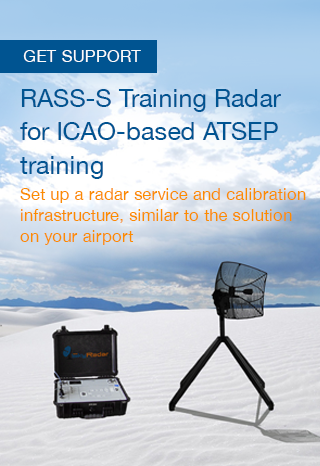ATC training is costly. But the personnel needs to be qualified, including regular refresher trainings. How to be able to afford the right unit and continuation training for ATSEP and ATCO in the same time? Here is a solution.
The ATC training world is pretty much under pressure. 8.2 Billion Air Travellers expected by 2037, systems need to be dynamic to reduce CO2 waste, to allow for dynamic flight trajectories, operations need to be come for efficient and safety expectations are continuously on the rise.
With increased competition also between national airports (like the Dubai-Turkey competition on dominating the Europe-Asia axis) but also the general massive funding which is consumed through the growth of air traffic and air traffic management, budgets are tight.
So let us try to find solutions which cater for our requirements and do not jeopardize our spending budget. Or formulated more lapidar, how can we get several meals for the price of one?
5 points to address when conceiving a training solution
When we plan a solution, it would be great to have a holistic one, embracing
- ATCO procedural training for Unit and Development Training
- ATSEP service and maintenance training Unit and Development Training
Here are the points which we consider relevant:
- Conceive an End-to-End solution, representing the whole signal conversion and visualisation chain
- Use ICAO standardized solutions and communication instead of toys
- Include all important solutions, namely TWR, ACC, APP, Communication, Surveillance, NavAids, Data, and BITE.
- Make sure the system is modular and extendable
- Make sure that double use for ATCO and ATSEP is possible
In the following we will address each of these 5 points independently.
1. Conceive an End-to-End solution, representing the whole signal conversion and visualization chain
This point addresses the depth of the solution. Let me illustrate it with the example of an aerodrome simulator. Often such solutions are just a simple and monolithic visualization of the front end. If accomplished in a sufficient quality, that may serve ATCO training. Processes are there and the trainees can practice with it.
The initial assumed price advantage will loose its charm when we look at its value for the ATSEP. In fact it is close to zero. ATSEPs need more. They need to be able to run through the whole signal chain up to the radar, or the NavAids system.
We always advise to use an operational system (with simulated sensor inputs), with a real VCS included (communicating with Pseudo-Pilots) and the proper chain of components, incl a synchronizer for the GPS signal. In addition we suggest some real radar inputs and secondary signals. We at SkyRadar therefore provide a full ATC system and simulate the sources. In addition we suggest to connect it to the ANSP's live data. And also we advise to connect educational primary radars (modularized to allow the ATSEP to walk and measure through it step by step).
How can we connect it all, and what systems should be included?
2. Use ICAO-standardized solutions and communication instead of toys
We do not like proprietary solutions. Such things are either built to produce cheap or to create a lock-in that keeps competition out. But what reasons could a manufacturer have to lock out competition other than the fact that he is convinced of the inferiority of his own stuff.
From our point of view, systems need to embrace standards like ASTERIX-based communication.
The reasons:
- standards need to be trained in ATSEP training anyway
- they are the prerequisite for the next point: extendability
- a standardized design allows to link in existing operational solutions (e.g. Radnet or ADS-B and weather data)
3. Make sure the system is modular and extendable
ICAO requires that a training solution for Unit and Development training is as close to the real environment as possible. This implies that it is not monolithic but adaptable.
Screen layouts and flows should be similar to the operation system.
But there is more reasons to that:
- standards and requirements change. Instead of scrapping the whole system every 3-5 years, it should be modular and evolutional. Sometimes a service contract can ensure this and cushion risks of additional and unplanned costs
- often, the initial budget is not enough to buy an exhaustive solution. So adding on components every year would be the solution.
4. Include all important solutions
What is important? This is a very subjective question that might need discussion based on the actual project.
 This here is my suggestion of a generic set up, which might need case-by-case tweaking:
This here is my suggestion of a generic set up, which might need case-by-case tweaking:
- Principle Control Center types
TWR, GND, ACC, APP are the most relevant features which an ATCO needs to be proficient in. Then ground related solutions like Advanced Surface Movement Guidance and Control System (ASMGCS) would be beneficial if available at the airport. TWR / GND requires 3D visualization, all other solutions can be 2D. The layout for the screens (Controller Working Position) should be close to the real life environment. Airport and FIR need to be modeled.
Typical features are- Simulation of Navigation Equipment
- Simulation of Surveillance Equipment (Primary and secondary radars, weather radars, ADS-B and MLAT systems, etc)
- OPTIONAL: Aeronautical Information Services (AIP), describing potential impact factors on the traffic
- Data Structure and System Architecture

The solution should consist of the major subsystems, implemented in a set of servers like the life system and consist of the following functional units like- Data Processing Units
- System Monitoring & Control
- Voice and Communication system
- CWPs
- RDPS
- FDPS
- Synchronizer
- GPS
- Primary Surveillance Radar (training solution)
- ADS-B Radar (training solution)
- Built-in test Equipment RASS-S
- Live Data (can be aggregated to the simulated data)
Possible inputs of live data (coming from the operational system):- Meteorology, parameters, impact on the traffic
- PSR data
- ADSB data
- MLAT data
- PAR Data
- Flight Data

5. Dual use for ATCO and ATSEP
Now make sure that the system, from a pedagogical point of view is optimized for both, ATCO and ATSEP.
ATCOs need good and realistic simulation, a good training arrangement, the possibility to record and replay the solutions and to have positions for supervisors, pseudo-pilots and potentially for exercise preparation.
The ATSEP needs a useful physical arrangement of all components and accessible measurement points.
He furthermore needs BITE possibilities and working positions for system surveillance and analytics as well as for the RASS-S.
Conclusion
We talked more about the ATSEP than ATCO in our quest to reach the dual use architecture. The answer is easy: the ATCO is more oriented on procedures, the ATSEP more on the real architecture. And replicating the real architecture takes more effort.
But as seen above, it is technically feasible, economical and makes absolute sense.




